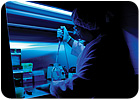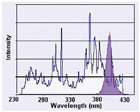A New Light
SLM
resolves end user complaints about traditional arc lamps.

The science behind creating UV-curable materials has grown into a billion-dollar-plus industry, enabling new applications for curing across many markets. UV curing offers its users savings in both time and money, as well as relief from increasingly restrictive environmental regulations. As materials have progressed, so too must UV light-source technology. Creating UV light with the desired properties has evolved with recent significant improvements, demonstrating that there is a new light on the horizon. Phoseon’s Semiconductor Light Matrix (SLM) Technology solves the following problems that UV light source users have expressed.

Electricity prices for industrial uses in the United States have more than tripled over the last 20 years. Therefore, end users are paying closer attention to electrical requirements of their production equipment. Electrical consumption (kW/hr) is reduced up to seven times when using SLM Technology vs. traditional arc lamps.
Traditional arc lamps operate at a very high temperature (850-950°C), requiring air extraction and an additional burden on the factory HVAC system. When using SLM technology, which operates at 60°C, there is no requirement for air extraction.
Traditional arc lamps create light from mercury vapor, which means that discarded lamps cannot simply be thrown away. Therefore, there is a cost associated with waste removal.
Labor costs associated with lamp replacement and maintenance are virtually eliminated when using SLM Technology.
Figure 1 compares relative operating costs to SLM technology using traditional arc lamp technology as the baseline at a factor of 1.
Replacement of UV lamps involves the time it takes to physically change the bulb, in addition to cooldown and warmup time. Many arc lamps also use special reflectors to filter unwanted wavelengths of light. These reflectors must be inspected, cleaned and replaced when necessary, which can take up to five hours each quarter.
Since SLM technology has a significantly longer lifetime, downtime associated with changing UV sources is reduced from perhaps once a month to once a year or less. The improvement in system uptime associated with UV light source replacement alone is reported to be from 97% with arc lamps to greater than 99% when using SLM Technology.

Feedback from end users who have replaced arc lamps with SLM technology indicates that yield improvements have gone from 95% to 99%. This is particularly true for UV curing of pressure-sensitive adhesives, wherein too much or not enough UV dose will require that the product be scrapped.

Traditional arc lamps emit light over the full spectral range. When oxygen molecules (O2) are exposed to light in the 180-220nm wavelength range, they split into (O) atoms and recombine with oxygen molecules (O2) to form triatomic oxygen (O3) or ozone. Ozone is a hazardous material that must be extracted. Conversely, SLM technology produces only the targeted UV light, which does not produce ozone (see Figure 3).
For more information on SLM technology, contact Phoseon Technology, 7425 NW Evergreen Parkway, Hillsboro OR 97124; phone (503) 439-6446; fax (503) 439-6408; e-mail info@phoseon.com; or visit www.phoseon.com.

The science behind creating UV-curable materials has grown into a billion-dollar-plus industry, enabling new applications for curing across many markets. UV curing offers its users savings in both time and money, as well as relief from increasingly restrictive environmental regulations. As materials have progressed, so too must UV light-source technology. Creating UV light with the desired properties has evolved with recent significant improvements, demonstrating that there is a new light on the horizon. Phoseon’s Semiconductor Light Matrix (SLM) Technology solves the following problems that UV light source users have expressed.
- Operating Cost: Ever-increasing energy costs have focused attention on not only electrical efficiency but also overall operating costs.
- Productivity: Frequent bulb replacement is disruptive to manufacturing, thus decreasing productivity.
- Yield: Reliability associated with a drop in UV output over time causes yield issues.
- Heat: Excessive heat distorts parts.
- Regulatory Compliance: Increasing regulatory constraints have made end users more aware of what new technologies are being integrated into their production lines.

Figure
1. Comparison of Operating Cost between Arc Lamp and SLM Technology
Operating Cost
The savings realized from using SLM technology cover both reduced down time and actual operating costs.Electricity prices for industrial uses in the United States have more than tripled over the last 20 years. Therefore, end users are paying closer attention to electrical requirements of their production equipment. Electrical consumption (kW/hr) is reduced up to seven times when using SLM Technology vs. traditional arc lamps.
Traditional arc lamps operate at a very high temperature (850-950°C), requiring air extraction and an additional burden on the factory HVAC system. When using SLM technology, which operates at 60°C, there is no requirement for air extraction.
Traditional arc lamps create light from mercury vapor, which means that discarded lamps cannot simply be thrown away. Therefore, there is a cost associated with waste removal.
Labor costs associated with lamp replacement and maintenance are virtually eliminated when using SLM Technology.
Figure 1 compares relative operating costs to SLM technology using traditional arc lamp technology as the baseline at a factor of 1.
Productivity
When the curing process stops working due to insufficient UV output, the output is typically replenished by replacing the UV source. The UV source replacement frequency, as well as general maintenance, will impact productivity. The expected lifetime for arc lamps is 500-1000 hours, compared to >10,000 hours for SLM technology. (Arc lamps will continue to generate output, but when the output drops below the process window for a given application the lamp must be replaced.)Replacement of UV lamps involves the time it takes to physically change the bulb, in addition to cooldown and warmup time. Many arc lamps also use special reflectors to filter unwanted wavelengths of light. These reflectors must be inspected, cleaned and replaced when necessary, which can take up to five hours each quarter.
Since SLM technology has a significantly longer lifetime, downtime associated with changing UV sources is reduced from perhaps once a month to once a year or less. The improvement in system uptime associated with UV light source replacement alone is reported to be from 97% with arc lamps to greater than 99% when using SLM Technology.

Figure
2. Comparison of Lifetime between Arc Lamp and SLM Technology
Yield
SLM technology makes monitoring UV light source operating parameters easier to ensure higher yield. Since SLM technology does not drop over time like arc lamps, the process is more reliable, reducing down time while increasing yield (see Figure 2).Feedback from end users who have replaced arc lamps with SLM technology indicates that yield improvements have gone from 95% to 99%. This is particularly true for UV curing of pressure-sensitive adhesives, wherein too much or not enough UV dose will require that the product be scrapped.
Heat
Many applications are sensitive to heat, e.g., printing onto plastics or styrene. Since SLM technology operates at less than 60°C - while lamps operate at more than a factor of 10 higher temperatures - the risk associated with excess heat is correspondingly less.
Figure
3. Comparison of Output Intensity and Wavelength between Arc Lamp and SLM Technology
Regulatory Compliance
The need for restricting the use of hazardous substances and solvents is becoming more of a deciding factor for moving to UV-cured materials to address restrictions on solvents. However, considerations must also be made for the UV light source itself. Traditional arc lamps use an electric discharge from mercury vapor to produce light. At the moment, arc lamps are exempt from the reduction of hazardous substances (RoHS) directive, but concerns related to having such a toxic substance in the workplace remain.Traditional arc lamps emit light over the full spectral range. When oxygen molecules (O2) are exposed to light in the 180-220nm wavelength range, they split into (O) atoms and recombine with oxygen molecules (O2) to form triatomic oxygen (O3) or ozone. Ozone is a hazardous material that must be extracted. Conversely, SLM technology produces only the targeted UV light, which does not produce ozone (see Figure 3).
Conclusion
SLM technology works to solve many of the problems resulting from the use of traditional arc lamps, and also helps to simplify the UV curing process. SLM technology is available to answer the call for a better UV light source.For more information on SLM technology, contact Phoseon Technology, 7425 NW Evergreen Parkway, Hillsboro OR 97124; phone (503) 439-6446; fax (503) 439-6408; e-mail info@phoseon.com; or visit www.phoseon.com.
Links
Looking for a reprint of this article?
From high-res PDFs to custom plaques, order your copy today!





